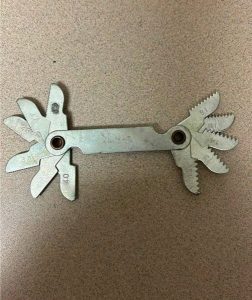Revolutionize Your Engineering Game: The Secret Weapon for Perfect Threads Revealed
In the fast-paced and exacting world of engineering and manufacturing, precision is everything. And when it comes to threaded components, there’s one tool that every engineer and machinist should have in their toolkit: the thread pitch gauge. This small, yet mighty instrument plays a critical role in ensuring that every bolt, screw, and nut meets the highest standards of accuracy and compatibility. If you’re serious about getting perfect threads every time, the thread pitch gauge is your go-to secret weapon.

What Exactly is a Thread Pitch Gauge?
At first glance, a thread pitch gauge might not seem like much. It’s a compact, thin plate, often made of metal, with teeth or notches of various sizes. Each set of teeth corresponds to a specific thread pitch, which is the distance between the threads on a screw or bolt. Despite its simple design, this tool is an essential part of any precision engineering setup.
By quickly and accurately measuring the thread pitch of a component, this gauge helps to ensure that parts will mate perfectly with their corresponding counterparts—whether that’s a nut, a hole, or another threaded component. Without the use of a thread pitch gauge, small variations in thread pitch could lead to parts not fitting together properly, which in turn can cause major issues in both assembly and overall function.
Measuring Bolts with Precision
One of the most common uses for a thread pitch gauge is to measure bolts. Bolts come in all sorts of sizes and thread types, and determining the correct pitch is crucial. The thread pitch gauge allows machinists and engineers to measure the spacing between threads with high accuracy, ensuring the bolt will fit perfectly with standardized nuts or holes.
It’s not just about fitting, though. This level of precision prevents threading problems like cross-threading or stripped threads, which can lead to damaged parts or faulty assemblies. When every millimeter counts, using a thread pitch gauge ensures compatibility and proper function in both small-scale and heavy-duty applications.
Enhancing Quality Control
The real magic of the thread pitch gauge is how it revolutionizes quality control. In any manufacturing environment, ensuring that every part meets exact specifications is crucial. A thread pitch gauge allows for quick inspections on the production line, ensuring that every threaded component meets industry standards.
Whether it’s used in delicate machinery where precision is vital, or in large-scale industrial applications, this tool helps maintain uniformity in every threaded connection. By identifying any deviations in thread pitch early, it prevents costly assembly issues down the line and guarantees that parts will work together seamlessly.
The Silent Arbiter of Precision
Though it often works behind the scenes, the thread pitch gauge is an unsung hero in the world of manufacturing. It ensures that every bolt and screw meets the rigorous precision standards required across a wide variety of industries, from automotive to aerospace. The gauge silently performs its role, helping engineers produce flawless threaded components without fail.
Versatile Types for Varied Threads
One of the best things about thread pitch gauges is their versatility. These tools come in different forms to fit a wide range of thread profiles. For example, there are metric gauges, imperial gauges, and even specialized gauges designed for pipe threads or tapered threads. Each type of gauge is precision-crafted to match the specific characteristics of the threads it’s meant to inspect.
This flexibility ensures that engineers can always find the right tool for the job, no matter what type of thread they’re working with. Whether you’re working with fine threads on delicate equipment or heavy-duty threads in large machinery, there’s a thread pitch gauge designed to help you get it right every time.
In the realm of precision engineering, the thread pitch gauge is an indispensable tool that ensures accuracy, quality, and compatibility in threaded components. Its ability to measure thread pitch with precision, enhance quality control, and maintain uniformity in assemblies makes it an essential asset in any manufacturing environment. So, if you haven’t added this secret weapon to your toolkit yet, it’s time to do so. Your projects—and your threaded components—will thank you.





